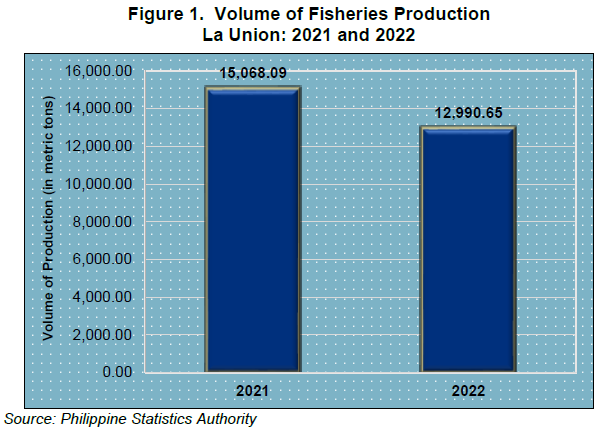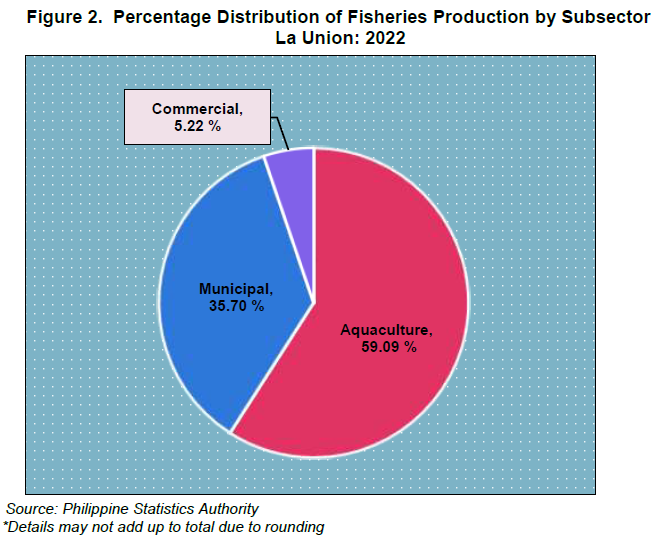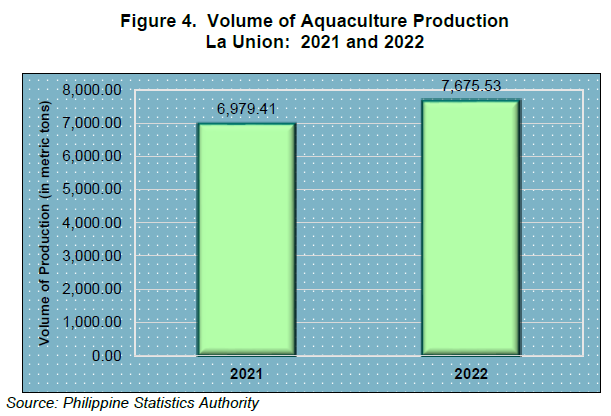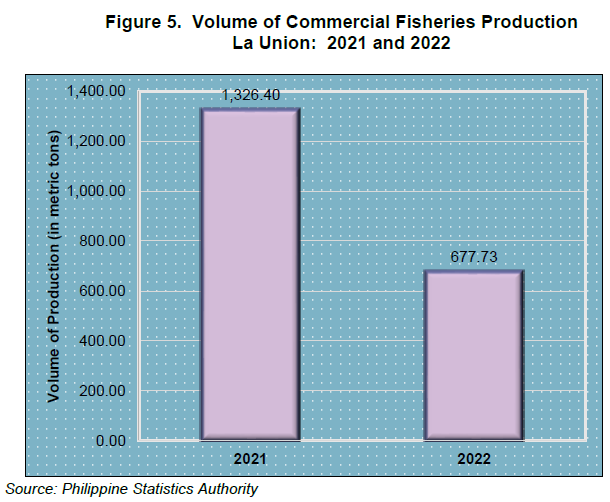La Union’s fisheries production decreases in 2022
La Union’s total volume of fisheries production in 2022 was recorded at 12,990.65 metric tons, a decrease of 13.79 percent from the 15,068.09 metric tons production in 2021.

Among the fisheries subsectors, aquaculture posted the largest contribution to the fisheries output in the province in 2022 with a share of 7,675.53 metric tons or 59.09 percent to the total fisheries production of the province. Municipal fisheries ranked second with 4,637.40 metric tons contributing 35.70 percent to the total fisheries production of the province. Commercial fisheries had the smallest contribution to the total volume of fisheries production in the province with 677.73 metric tons or 5.22 percent share.

In 2022, the top five species in terms of volume of production were: Milkfish (Bangus) with 5,255.65 metric tons (40.46 percent share); Grouper (Lapu-lapu) with 995.01 metric tons (7.66 percent share); Tilapia with 573.74 metric tons (4.42 percent share); Tiger prawn with 357.85 metric tons (2.75 percent share); and Threadfin bream (Bisugo) with 342.07 metric tons (2.63 percent share).
Municipal Fisheries
The total municipal fisheries production in La Union decreased by 31.42 percent from the estimated production of 6,762.28 metric tons in 2021 to 4,637.40 metric tons in the 2022. This subsector was comprised of 90.16 percent production from marine municipal fisheries and 9.84 percent production from inland municipal fisheries
Similarly, the volume of production from marine municipal fisheries dropped by 31.05 percent from 6,064.04 metric tons in 2021 to 4,181.08 metric tons in 2022. Likewise, the volume of production from inland municipal fisheries went down by 34.65 percent from 698.24 metric tons in 2021 to 456.32 metric tons in 2022.

Municipal fisheries data were gathered from administrative records of the Philippine Fisheries Development Authority (PFDA), Local Government Unit (LGU) - managed landing centers and traditional landing centers.
Aquaculture
The aquaculture production in La Union was posted at 7,675.53 metric tons in 2022. This translates to an increase of 9.97 percent from the 6,979.41 metric tons production in 2021. (Figure 4)
Milkfish dominated the aquaculture production of the province in 2022 with 5,254.42 metric tons. It was distantly followed by Grouper and Tilapia production with 811.46 metric tons and 489.89 metric tons, respectively. Milkfish production decreased compared with its output of 5,987.87 metric tons in 2021. On the other hand, Grouper and Tilapia production recorded increases from their outputs of 1.55 metric tons and 461.95 metric tons, respectively, a year ago.

Commercial Fisheries
The volume of production from commercial fisheries was posted at 677.73 metric tons in 2022. It went down by 48.90 percent from 1,326.40 metric tons a year ago. (Figure 5)
Data for commercial fisheries were obtained from LGU-managed fish landing centers, privately-managed fish landing centers, and traditional fish landing centers.

Value of fisheries production in La Union increases in 2022
The total value of all fisheries production in La Union in 2022 was PhP2,582,427.58. This is 22.69 percent higher than its value a year ago of PhP2,104,771.71.
In terms of value of production, aquaculture topped the three subsectors in 2022 with a share of 64.58 percent to the total value of fisheries production in the province. The remaining 35.42 percent of the provincial total value of production was contributed by municipal fisheries with 31.77 percent share and commercial fisheries with 3.65 percent share. (Figure 6)
Aquaculture subsector exhibited an increase of 91.38 percent from its value of production a year ago of PhP871,460.29. On the contrary, municipal and commercial subsectors showed a decrease in their respective value of fisheries production compared with their value of fisheries production in 2021. Municipal fisheries value of production decreased by 23.03 percent from PhP1,065,920.09 in 2021 to PhP820,406.26 in 2022 while commercial fisheries value of production went down by 43.69 percent from PhP167,391.33 to PhP94,263.10.

Aquaculture is a fishery operation involving all forms of raising and culturing of fish and other fishery species in fresh, brackish and marine water areas. The operation is comprised of activities from stocking to harvesting of species under controlled conditions in farming facility called aquafarm.
Aquaculture Production refers to the volume harvested from the aquafarm. It includes those species harvested in marketable/matured size and in fresh form.
Inland Municipal Fishing – the catching of fish, crustaceans, mollusks and other aquatic animals and plants in inland waters like lakes, rivers, dams, marshes, etc. using simple gears and fishing boats some of which are non-motorized with a capacity of less than three gross tons, or fishing not requiring the use of fishing boats.
Landing Center is a place where the fish catch and other aquatic products are unloaded and traded. Traditional landing center is a type of landing center where fishermen could unload their catch and/or dock their fishing boats without any obligation or payment for the use of the place.
Quarterly Aquaculture Survey is a quarterly survey that generates estimates of volume and value of production per aquafarm type and species for the subsector.
Quarterly Inland Fisheries Survey is a survey on volume and price of fish by species, caught by households engaged in inland fishing. It gathers quarterly data with monthly catch from sample fishing households. Respondents are fishermen or any knowledgeable member of the sample household.
Quarterly Commercial Fisheries Survey (Traditional Landing Center) is a quarterly survey on the volume of fish unloading in traditional landing centers and the price of fish by species. It gathers data on a quarterly basis but the information that is collected is about monthly fish unloading.
Quarterly Commercial Fisheries Survey (Philippine Fisheries Development Authority (PFDA), Local Government Units (LGUs), Privately-Managed Landing Centers) is the gathering of data from the records of the PFDA, LGU and privately-managed landing centers. It is done on a quarterly basis but the information being collected is on each of the three months included in the reference quarter.
Quarterly Municipal Fisheries Survey (Traditional Landing Center) – is a survey on volume and price of fish, by species, unloaded by fishing boats three gross tons or less. It gathers quarterly data for the entire sample landing center with information on monthly fish unloading.
Quarterly Municipal Fisheries Survey PFDA, LGUs, Privately-Managed Landing Centers is gathering of data on volume and price of fish from administrative records of PFDA and LGU managed landing centers. It is done on a quarterly basis with information from three-month period.
SGD. DANITES E. TEÑIDO, PhD
Chief Statistical Specialist
MAQ/MFC

